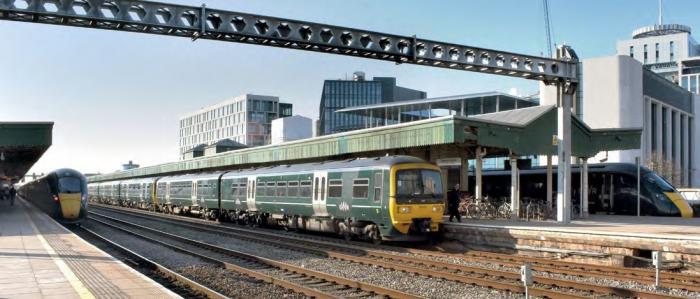News Front
Service intensification does not depend on completion of wires to Cardiff

GREAT WESTERN Railway is hoping to bring passengers the benefits of electrification between Cardiff and London at the December timetable change. When Network Rail confirmed that the energisation date for the final section of electrification, between Bristol Parkway and Cardiff Central, had been deferred to November 2019, it appeared that service changes to capitalise on the project’s completion would also have to be deferred. Following the difficulties encountered last year, the rail industry as a whole is taking a more cautious approach to major timetable changes, particularly those which are dependent on timely completion of infrastructure works.
However, the performance of the Intercity Express Trains between Bristol Parkway and Paddington, where electrification is complete, has inspired confidence at GWR that the proposed additional services could be operated from December without significant risk to performance, regardless of whether electrification in South Wales is completed in November.
SPEED-UP
Headline improvements are a 15-minute reduction in journey times between South Wales and Paddington, and the doubling of services between Bristol Temple Meads and Paddington, exploiting the recently completed four-tracking of Filton Bank, north of Temple Meads. ‘Some of the Bristol fast services might be introduced slightly later’ said GWR managing director Mark Hopwood. GWR proposes to increase service frequency from two to three trains per hour from Cardiff to London in the morning peak and from London to Cardiff in the evening peak. One of those trains per hour, working from and to Swansea, would omit some intermediate station calls to save slightly more than 15 minutes. ‘The electrification work is moving forward at a steady pace. We’ve got confidence that that will come in,’ said Mr Hopwood. ‘Even if we didn’t have the electrified railway west of Bristol Parkway, it wouldn’t put the whole timetable at risk.’ The outcome of GWR’s bidding for the proposed timetable changes will not be known until late spring or early summer.
Mr Hopwood acknowledged that GWR’s performance last year had been affected by line closures and other difficulties, including timescales for crew training being compressed as a consequence of late completion of earlier sections of electrification. Performance had improved significantly, and fewer trains were being short formed. Last year’s short formations included five-car IETs frequently replacing eight-car HSTs. Five-car IETs are still occasionally deployed, but only as a last resort and sometimes to avoid cancelling a service following disruption, said Mr Hopwood.
The 10-car IET formations can be split to provide two trains in such circumstances, a flexibility which was not available with HSTs.
TURBOS TO POMPEY
On the inter-urban route between Cardiff and Portsmouth Harbour, five-car trains were now being deployed more consistently, Mr Hopwood said, some being Class 166+165 formations and others Class 158s. Some passengers are dissatisfied with the 3+2 seating of the former Thames Valley commuter stock, but Mr Hopwood said 2+2 seating was available in former first class sections.
The route connects several cities and carries large numbers of passengers into their nearest city. Mr Hopwood said short-distance passengers wanted different things from their trains than the longer-distance passengers. The long-term solution was to create a limited stop service, but this could only happen with sufficient infrastructure and rolling stock to enable provision of local services without loss of service frequency for users of the smaller stations. Another option for the future is deployment of bi-mode trains, such as Class 769 Flex units, between Cardiff and Bristol Temple Meads, where the current journey time is a cause of complaint and there are plans for several additional stations. Electric operation between Cardiff Central and Patchway would enable faster acceleration from stations, which Mr Hopwood said would generate a small saving in journey times.
The Welsh Government has commenced a £50 million project to create a park and ride station at Llanwern, with stabling sidings for special event days, and is co-funding the planned Cardiff Parkway station, east of Cardiff Central. Monmouthshire County Council has been promoting a ‘walkway’ station at Magor, west of Severn Tunnel Junction. Mr Hopwood said it was important to consider the impact of any new stations on journey times for existing passengers. While bi-mode operation was a possibility for the future, GWR was not currently planning to use its Class 769s as far west as Bristol. He confirmed that GWR could operate 12-car Class 387 formations from London to Cardiff for weekend events in the Welsh capital that draw large numbers of spectators from England. For major events in Cardiff on weekday evenings, Class 387s could be sent onwards from their Swindon base after the evening peak to help with the surge of passengers requiring homeward transport.
